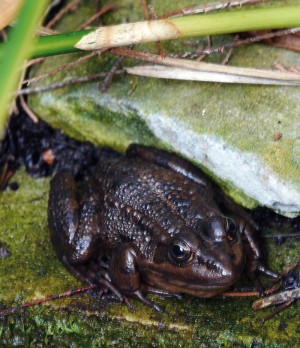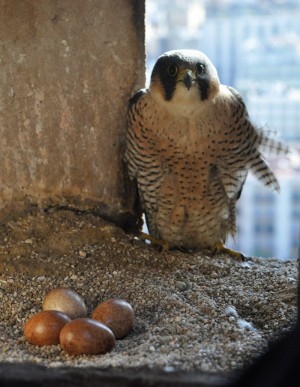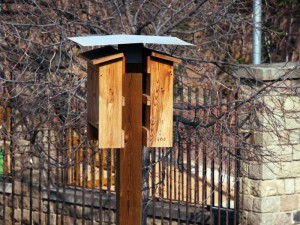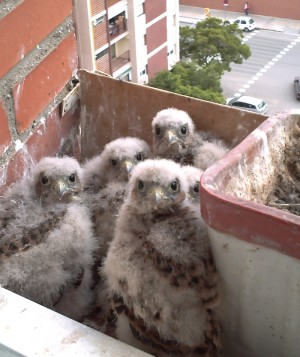The reintroduction of the peregrine falcon, the Swallow Project and a pond management system that benefits amphibians and other aquatic creatures are examples of successful initiatives implemented to protect and give prominence to Barcelona’s natural heritage.

Frog in a pond in Ferran Soldevila garden, part of the University of Barcelona’s historic grounds. Over the last decade the maintenance of the city’s ponds has included a comprehensive protection pro-gramme for the amphibians living in them.
Photo: Vicente Zambrano
The falcon, a bird that has such strong associations with mediaeval history and has inspired Iberian literature and legends, couldn’t pass over a city like Barcelona. Indeed, it always had a presence here until the early seventies, when the last breeding pair in Barcelona was killed, pulled from its nest in one of the svelte gothic towers of Santa Maria del Mar. Action to remedy this loss didn’t occur until 1999, when a municipal project to reintroduce the peregrine falcon, following successful examples of programmes to reintroduce the species in the USA, saw them return to the city.
This successful experience, which was headed up by the biologist Eduard Durany and involved the Galanthus Association (AG), was the first major initiative to bring urban wildlife closer to the public, with the aim of presenting the city as a part of nature rather than as its antithesis. Between 2004, when the first chicks were born, and 2016, 78 new falcons have been flying around Barcelona. Some have stayed in the city but the majority have left to colonise new areas. We currently have at least two breeding pairs: one at the iconic Sagrada Família and the other on the sea cliffs of Montjuïc.
The wide media coverage of this project, which even today, 18 years later, makes headlines, encouraged us to propose other similar initiatives. The city could not turn its back on its small, limited but valuable wild natural heritage: it had an obligation to give prominence to those genuinely urban species, such as swallows and swifts, and those that could be, such as kestrels and crows, which do so much for us, from providing us with ecosystems to giving us the pure pleasure of observing them. Some town planners argue that a city’s quality of life is determined by the range of opportunities its offers and that the enjoyment of nature is one of those opportunities.
The Swallow Project
In 2005, the Swallow Project (Projecte Orenetes) was launched, comprising an awareness-raising campaign, a census and a participation element so that members of the public could, through various communication channels, send in reports of common house martins or barn swallows nesting in their homes. In 2016, they counted 280 nests occupied by house martins and a few dozen by barn swallows, which, though more usually found in rural settings, are now returning to parts of the city that not so long ago were villages surrounded by fields and crops.
Over time, the Swallow Project led to an action plan to protect birds and other wild and protected animals that breed in buildings, such as alpine and common swifts. We have counted 367 colonies of alpine swifts in the city, which translates to 3,670 pairs, since each colony has, on average, ten pairs. This is a significant volume in relation to the total alpine swift population in Catalonia. In an effort to conserve all this interesting wildlife, in partnership with the Catalan Regional Government and the the Rural Agents Corp (CAR), nests have been installed for barn swallows, house martins, common swifts, alpine swifts, kestrels, falcons and bats. More importantly, builders and architects have been advised on how to incorporate nesting places into new builds and to conserve any existing nests during renovation projects.
Bats and hedgehogs against insects
A recent project to foster urban biodiversity by setting up artificial nests involved placing rat roost columns in city allotments as a means of integrating natural management into these facilities. Bats are a tool that could help to combat swarms of mosquitoes and other insects.
Similarly, a project is in the pipeline to boost the city’s hedgehog population by installing nesting boxes. This is, to a certain extent, the continuation of a study of Barcelona Zoo and Ciutadella Park populations of this unmistakeable insectivorous mammal, carried out in conjunction with Barcelona Zoo’s Green Team in 2007. In addition to this very urban population of hedgehogs, we have identified others in Horta and Sant Andreu, yet another example of how wild animals are venturing deeper into the city. It’s a phenomenon that must be accompanied with appropriate management systems that enhance the biodiversity and, consequently, our quality of life.
The pond-dwellers
Adapting green space management designed to achieve greater biodiversity by incorporating new paradigms can deliver some fantastic results. One example of this is seen in the management of the city’s natural ponds. In 2007, with the help of a young biology doctorate, Guillem Pascual – who even as a boy was catching tadpoles in the ponds of Montjuïc and Laberint d’Horta – we presented a proposal to the City Council to carry out a survey of the ponds in the city’s parks and public gardens that were inhabited by amphibians. We found 56 breeding sites.
After this survey and in the years that followed, we produced management reports, boosted the amphibian population and routinely rescued wildlife during the cleaning of ponds. These actions have now culminated in a protection programme that is fully integrated into pond maintenance procedures. In fact, Barcelona is probably the only city in Spain with such a programme.
The result of all this is an increase in breeding sites, in some cases through natural colonisation. There are currently 87 such sites, leading to the stabilisation of the three amphibian species that live in the city: the Mediterranean tree frog, the Perez’s frog and the common midwife toad. The conservation of the latter species, thus named because the males are responsible for carrying the fertilised eggs and releasing the tadpoles, has been very successful. In fact, in 2010 and 2011, thousands of tadpoles were taken from Barcelona to repopulate ponds in the Llobregat delta, where the species had become extinct. It stands out as an unusual example of a protected species being given by a city to a natural area.
Good pond conservation helps other aquatic animals too. The dragonfly population has also grown, to the extent that five or six species of dragonfly nymphs can be found around the ponds in our parks, such as the Anax imperator, Europe’s largest dragonfly, and the elegant, bright scarlet Crocothemis erythraea.
The ponds are also home to several species of water snails, bugs, fleas and mayflies. Adult mayflies only live for a few hours or days, at most, after hatching: their only mission in life is to reproduce. They form swarms that attract hundreds of insect-eating birds, primarily swallows. In late summer, these flocks of birds put on a veritable display near the ponds of the Mossèn Cinto Verdaguer gardens in Montjuïc, a park that also has a large collection of aquatic plants and all three of the amphibian species mentioned above. In this park, since the pond maintenance procedures were put in place, with the entire aquatic wildlife population being rescued and then returned each time the pond is cleaned, the Perez’s frog population has grown from 406 in 2010 to 1,144 in 2016: an increase that proves the indisputable benefits of good wildlife management.





